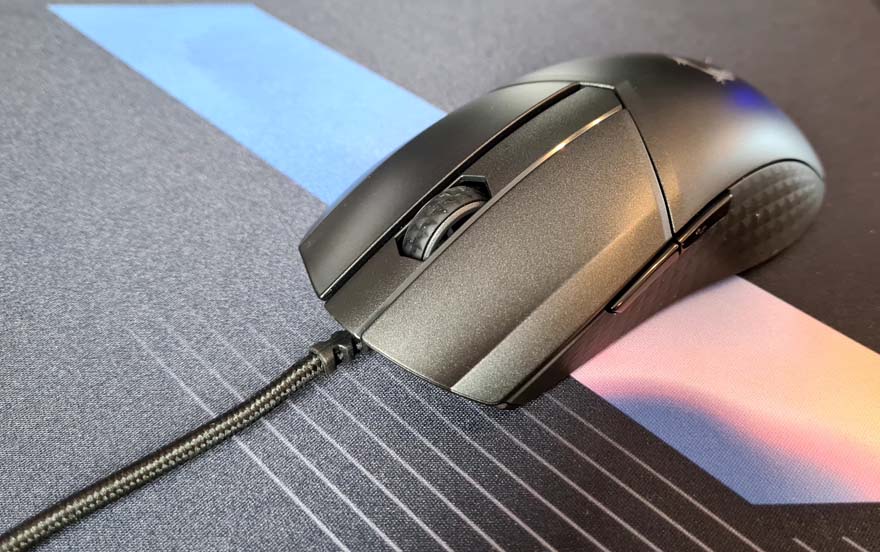MSI Clutch GM41 Lightweight Gaming Mouse Review
Peter Donnell / 4 years ago
A Closer Look & Performance
First impressions go a long way, and this mouse makes a great first impression. It does borrow some design elements from previous Clutch gaming mice, such as the GM50 I reviewed last year. However, it’s completely reshaped and is carving its own path within the Clutch range.
The most impressive thing I noticed, however, is the plastics. I’m not sure what MSI do to get that finish, but the soft metallic gunmetal look they get on their peripherals really is fantastic, and a nice change from the flatter greys and blacks we often see.

There’s a stunning 3D effect texture on the left side too, which is a hard-wearing rubber material that’s really comfortable to grip. However, it matches up with the more rigid plastic finish on the rest of the mouse really well.

You’ll find two navigation buttons down the left side, which are slimmed down compared to other mice in this series; no doubt in an effort to maintain that lower weight! However, they have lovely switches on them, with a much more tactile click and slightly stiffer springs than we find on most mice; which I think is a good thing, they feel great!

Down the right side, there’s even more of that 3D textured rubber grip. I like the looks and feel of it. It’s not likely to wear down like some rubber grip sides either, as the texture is more cosmetic and it’s the shape of the mouse that allows for the most grip overall. Of course, the mouse is cut to shape for right-handed users, so keep that in mind if you’re a lefty or ambidextrous.

The overall ergonomics are excellent, though. Being lightweight is one thing for comfort, but it’s a wasted effort if the shape is off. The left and right mouse buttons both have a nice shape, with a slight dip towards the nose that promotes a good finger position. However, they’re mounted in such a way that you can comfortably click the switch pressing at the back of the switch near the middle of the mouse just as well as you can at the front of the mouse.

The switches are Omron 60M rated, and they have a nicely defined click and tactile feel. They’re a little heavier to click than some mice, but not overly so, and I think that gives them a more responsive and positive feel.

On the base of the mouse, you’ll find three Teflon pads, which are super slippery. The mouse glides with ease anyway thanks to its 65g weight. However, with these on the bottom, it’s effortless to move around and also means that you can make really tiny adjustments without having to overcome any grip from your mouse mat.
Also located on the bottom of the mouse, you’ll find the stunning PixArt optical sensor, as well as the DPI toggle button. It may seem odd having the DPI down here, but if you compete in games, the last thing you need is to change it accidentally. It’s not so much right or wrong as it is a preference to have it here. I rarely change DPI, so for me, this works really well.

The mouse offers up 600/800/1600/3200/6400 DPI on a cycle through this button. However, there is some software so you can tinker with the defaults. Personally, I never felt the need, I just left it at 1600 DPI and felt that was more than enough for my work and gaming, even over a dual 4K monitor setup.

Lifting the mouse feels effortless, and at 65g it’s unlikely to tire you out pushing it around your desk all day and night. If anything, the cable is the most significant weight here, and you’ll find benefit in using a cable bungee to keep things free and clear. Not that the cable is heavy, it’s just the mouse is so light in comparison.

On the back of the mouse, you’ll find this lovely Dragon logo, which is the only RGB part of the mouse, but honestly, that’s all we really need.

However, the real star of the show isn’t the RGB, but the stunning PixArt optical sensor. It tracks flawlessly at all DPI levels, and even some aggressive fast waggling wasn’t enough to throw off the tracking. There’s no issue with acceleration or deceleration here.

Furthermore, there’s no evidence of angle snapping or correction, and you can draw sweeping and tight curves with no issues. However, it’s not the big movements that impress the most, but the little ones. Being able to use higher DPI and tiny twitchy movements have never been easier. You can make a 1mm move of the mouse with ease and accuracy, which can be great for those twitch shooters like CS:GO.

I actually like that this looks like a standard mouse. A lot of the ultralight mice look very different, with lots of materials cut-away. However, MSI has gotten down to their new lightweight design without compromising on the design. It’s not the




















